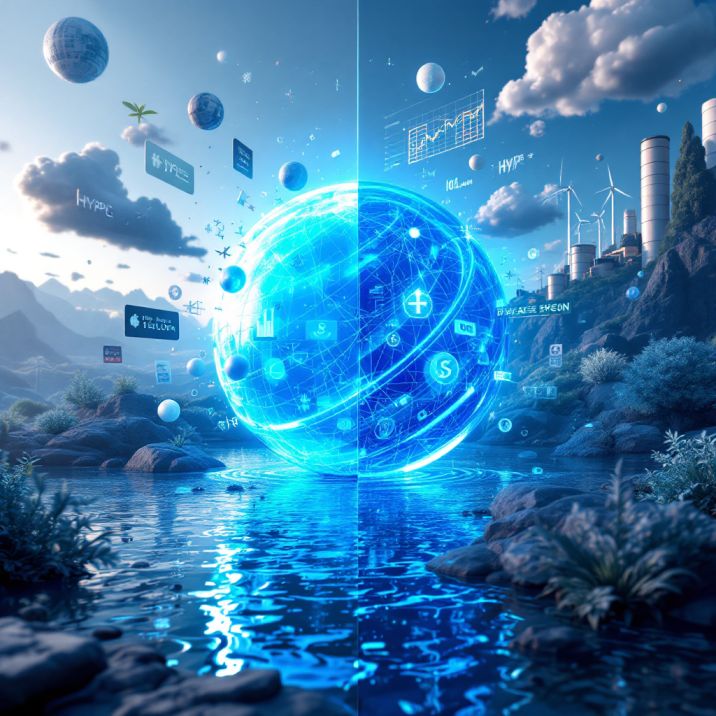Unveiling the Mystery: What Is Blue Gas?
Updated Oct 30, 2024
Blue gas, or blue hydrogen, has sparked interest as a low-carbon energy alternative. Produced from natural gas through steam methane reforming (SMR), blue hydrogen captures and stores carbon emissions, reducing its environmental impact.
Stepping Stone to Green Hydrogen: Blue hydrogen is a crucial transitional step towards a green hydrogen economy. Its current economic advantages over green hydrogen, produced via electrolysis and renewables, make it an attractive short-to-medium-term option for countries and industries aiming to lower carbon emissions.
Governmental Strategies: Several governments have included blue hydrogen in their energy transition plans. For example, the UK supports a “twin-track” approach, while Canada leverages its natural gas reserves and carbon capture and storage (CCS) technology to invest in blue hydrogen.
Corporate Investments: Major energy companies like BP, Shell, and Equinor also embrace blue hydrogen. BP, for instance, plans to establish a blue hydrogen production facility in the UK by 2027.
As the world grapples with the urgent need for clean energy solutions, blue hydrogen has emerged as a contentious player in transitioning away from fossil fuels. Today, we will examine the challenges and controversies surrounding blue hydrogen, exploring the complex interplay of technology, economics, and psychology that shapes its role in the global energy landscape.
Energy Intensity and Emissions: The Achilles’ Heel
The production of blue hydrogen is an energy-intensive process that relies on natural gas as a feedstock. While carbon capture and storage (CCS) technologies mitigate emissions, they are not 100% effective. Studies have shown that carbon capture rates often fall below the ideal 100%, resulting in residual greenhouse gas emissions. This reality challenges the notion of blue hydrogen as a “clean” energy source.
Moreover, methane leakage during natural gas extraction and transportation further complicates the environmental profile of blue hydrogen. Methane, a potent greenhouse gas, can escape at various points along the supply chain, potentially offsetting the carbon benefits touted by blue hydrogen proponents.
From a mass psychology perspective, the perception of blue hydrogen as a “cleaner” alternative to traditional fossil fuels can lead to the “halo effect.” This cognitive bias causes people to view blue hydrogen more favourably overall due to its association with reduced carbon emissions, potentially overlooking its other environmental impacts.
As the costs of renewable energy and electrolysis technologies continue to fall, green hydrogen – produced using renewable electricity – is becoming increasingly competitive. This trend has led some experts to argue that investing in blue hydrogen could divert crucial resources from developing green hydrogen, offering a more sustainable long-term solution.
Contrarian investors might see an opportunity in this dynamic. While most investment and attention is focused on blue hydrogen due to its perceived near-term feasibility, forward-thinking investors could position themselves ahead of the curve by betting on green hydrogen technologies and companies. This approach aligns with the contrarian investing principle of identifying undervalued opportunities that the broader market has yet to appreciate fully.
Crafting Blue Gas: Unveiling the Intricacies
Blue hydrogen, a low-carbon energy alternative, is produced through steam methane reforming (SMR) on an industrial scale. This process utilizes natural gas as feedstock, combined with steam, at high temperatures (700-1100 °C) to generate hydrogen and carbon monoxide. As of 2023, approximately 75-78% of global hydrogen production relies on natural gas for SMR, making it the cheapest source of industrial hydrogen.
The carbon monoxide produced in the initial reaction is then converted into additional hydrogen and carbon dioxide through the water-gas shift reaction. To achieve its “blue” status and reduce carbon emissions, carbon capture and storage (CCS) technology is employed to capture and store the carbon dioxide emissions underground.
However, CCS is not 100% effective, with capture rates ranging from 85% to 95% for blue hydrogen production. Additionally, methane leaks during natural gas extraction and transportation can further reduce the climate benefits of blue hydrogen. Studies indicate that blue hydrogen has a larger carbon footprint than initially marketed, and its environmental benefits depend on the source of electricity used in production.
While blue hydrogen presents an intriguing alternative, it faces challenges and limitations. As of 2024, only a handful of commercial blue hydrogen facilities are operating. The development of blue hydrogen infrastructure, including refuelling locations, contributes to high costs, impacting its accessibility and viability as a widespread alternative fuel.
Renewable energy sources, such as solar and wind power, must be utilized in production to reduce carbon emissions and achieve carbon neutrality. This shift would enhance the sustainability of blue hydrogen and reduce its overall environmental impact.
The Feasibility of Blue Gas: Exploring the Reality
The discussion around blue gas, or blue hydrogen, as a sustainable fuel source is multifaceted. While it offers a promising route to reducing emissions, particularly in hard-to-abate sectors, it also presents challenges and opportunities that must be addressed.
The Investment Landscape:
Subsidy Requirements: Scaling up renewable hydrogen technologies requires significant investment. Bloomberg New Energy Finance (BNEF) estimates that governments may need to provide approximately $150 billion in subsidies over the next decade to support their development and deployment.
Market Dynamics: As economies recover, the transition to sustainable fuels remains a priority. Electric vehicles, for instance, continue to gain traction, and Tesla’s stock performance reflects investor confidence in this sector.
Blue Gas vs. Electric Trucks:
Electric Truck Advantage: Research suggests electric trucks with a 400-kilometre range outperform diesel and hydrogen trucks. Electric motors near the wheels reduce weight, and advancements in battery technology address range and charging concerns.
Infrastructure Considerations: Expanding charging infrastructure for electric trucks is ongoing, and collaboration between stakeholders is crucial to overcoming limitations.
The Psychology of Blue Gas Investing: Navigating Hype and Reality
Mass psychology, cognitive biases, and contrarian thinking play significant roles in the perception and investment landscape of blue gas:
1. Herd Mentality: The buzz around blue gas as a potential “Tesla killer” can lead to bandwagon investing, where investors follow the crowd without thorough analysis.
2. Confirmation Bias: Proponents of blue gas may selectively focus on positive news, overlooking challenges in production, infrastructure, and environmental impact.
3. Anchoring Bias: Early optimistic projections about blue gas may anchor investors’ expectations, making it challenging to adjust views as new information emerges.
4. Contrarian Opportunities: While mass sentiment leans towards established electric vehicle technology, contrarian investors might see potential in blue gas, particularly in niche applications or regions with abundant natural gas resources.
5. Overconfidence Bias: Some investors may overestimate their ability to predict the future of energy markets, leading to risky bets on unproven technologies.
6. Loss Aversion: As the EV market grows, fear of missing out on the “next big thing” in energy could drive irrational investment in blue gas technologies.
7. Recency Bias: Recent successes in the EV market might lead some investors to underestimate the potential for alternative technologies like blue gas.
A contrarian approach to blue gas investing requires careful analysis of technological feasibility, market dynamics, and long-term sustainability rather than following market hype or fear.
Conclusion: Blue Gas and the Future of Clean Transportation
Marketing blue hydrogen as a clean alternative to traditional fossil fuels creates cognitive dissonance for many environmentally conscious individuals. While blue hydrogen is presented as a step towards decarbonization, studies reveal that its production still results in significant greenhouse gas emissions, particularly when considering the entire natural gas extraction and processing lifecycle.
This dissonance can lead to what psychologists call “motivated reasoning,” where individuals selectively interpret information to align with their preexisting beliefs or desired outcomes. Proponents of blue hydrogen may downplay its environmental drawbacks, while critics may overemphasize them, making it challenging for policymakers and investors to make objective decisions.
The concept of blue hydrogen as a “bridge” technology in the energy transition can create an anchoring effect in the minds of investors and policymakers. This cognitive bias causes individuals to rely too heavily on the first piece of information they receive when making decisions. In this case, the idea that blue hydrogen is a necessary stepping stone to a fully renewable energy system may anchor decision-makers to this path, potentially overlooking alternative solutions or more rapid transitions to green hydrogen.
Contrarian investors might recognize this anchoring effect and seek opportunities that challenge the prevailing narrative. For example, they might invest in companies developing innovative energy storage solutions or advanced electrolysis technologies that could accelerate the viability of green hydrogen, bypassing the need for a blue hydrogen “bridge.”
As governments and energy companies invest heavily in blue hydrogen infrastructure, including carbon capture and storage facilities, there’s a risk of falling into the sunk cost fallacy. This psychological trap leads decision-makers to continue an action because of previously invested resources, even when it may no longer be the most rational choice.
From a contrarian investing perspective, recognizing this fallacy could present opportunities. While others double down on blue hydrogen investments, contrarian investors might look for companies developing flexible energy infrastructure that can adapt to multiple clean energy sources, including blue and green hydrogen.
In conclusion, while blue gas holds promise, it faces an uphill battle against the established EV industry. The future of clean transportation will be shaped by ongoing technological advancements, market dynamics, and policy support for sustainable alternatives.
Engaging Mind Treats











